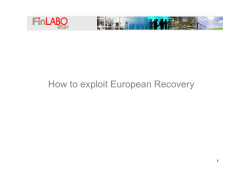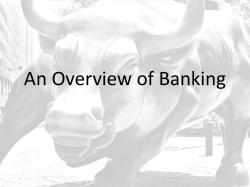
FIN 3318 Exam 2 Sample Questions (a) 1
FIN 3318 Exam 2 Sample Questions (a) 1 What does WRF = -0.50 mean? a) The investor can borrow money at the risk-free rate. b) The investor can lend money at the current market rate. c) The investor can borrow money at the current market rate. d) The investor can borrow money at the prime rate of interest. e) The investor can lend money at the prime rate of interest. (c) 2 The separation theorem divides decisions on _______ from decisions on _______. a) Lending, borrowing b) Risk, return c) Investing, financing d) Risky assets, risk free assets e) Buying stocks, buying bonds (d) 3 When identifying undervalued and overvalued assets, which of the following statements is false? a) An asset is properly valued if its estimated rate of return is equal to its required rate of return. b) An asset is considered overvalued if its estimated rate of return is below its required rate of return. c) An asset is considered undervalued if its estimated rate of return is above its required rate of return. d) An asset is considered overvalued if its required rate of return is below its estimated rate of return. e) None of the above (that is, all are true statements) (c) 4 The line of best fit for a scatter diagram showing the rates of return of an individual risky asset and the market portfolio of risky assets over time is called the a) Security market line. b) Capital asset pricing model. c) Characteristic line. d) Line of least resistance. e) Market line. (e) 5 Utilizing the security market line an investor owning a stock with a beta of -2 would expect the stock's return to________ in a market that was expected to decline 15 percent. a) Rise or fall an indeterminate amount b) Fall by 3% c) Fall by 30% d) Rise by 13% e) Rise by 30% USE THE FOLLOWING INFORMATION FOR THE NEXT THREE PROBLEMS You expect the risk-free rate (RFR) to be 3 percent and the market return to be 8 percent. You also have the following information about three stocks. STOCK BETA X 1.25 Y 1.50 Z 0.90 CURRENT EXPECTED PRICE PRICE $ 20 $ 23 $ 27 $ 29 $ 35 $ 38 EXPECTED DIVIDEND $ 1.25 $ 0.25 $ 1.00 (b) 6 What are the required rates of return for the three stocks (in the order X, Y, Z)? a) 16.50%, 5.50%, 22.00% b) 9.25%, 10.5%, 7.5% c) 21.25%, 8.33%, 11.43% d) 6.20%, 2.20%, 8.20% e) 15.00%, 3.50%, 7.30% (a) 7 What are the estimated rates of return for the three stocks (in the order X, Y, Z)? a) 21.25%, 8.33%, 11.43% b) 6.20%, 2.20%, 8.20% c) 16.50%, 5.50%, 22.00% d) 9.25%, 10.5%, 7.5% e) 15.00%, 3.50%, 7.30% (e) 8 What is your investment strategy concerning the three stocks? a) Buy X and Y, sell Z. b) Sell X, Y and Z. c) Sell X and Z, buy Y. d) Buy X, Y and Z. e) Buy X and Z, sell Y. (d) 9 Consider the following two factor APT model E(R) = λ0 + λ1b1 + λ2b2 a) b) c) d) e) (a) 10 λ1 is the expected return on the asset with zero systematic risk. λ1 is the expected return on asset 1. λ1 is the pricing relationship between the risk premium and the asset. λ1 is the risk premium. λ1 is the factor loading. Under the following conditions, what are the expected returns for stock X and Y? λ0 = 0.05 bx,1 = 0.90 bx,2 = 1.60 λ1 = 0.03 by,1 = 1.50 λ2 = 0.04 by,2 = 0.85 a) b) c) d) e) 14.1% and 12.9% 12.5% and 19.5% 19.5% and 18.5% 21.2% and 18.5% None of the above (a) 11 The table below provides factor risk sensitivities and factor risk premia for a three factor model for a particular asset where factor 1 is MP the growth rate in U.S. industrial production, factor 2 is UI the difference between actual and expected inflation, and factor 3 is UPR the unanticipated change in bond credit spread. Risk Factor MP UI UPR Factor Sensitivity(β) 1.76 -0.8 0.87 Risk Premium(λ) 0.0259 -0.0432 0.0149 Calculate the expected excess return for the asset. a) b) c) d) e) 12.32% 9.32% 4.56% 6.32% 8.02% (c) 12 The comparisons with which ratios should be made include the following, except a) The firm's own past performance. b) The firm's major competitor within the industry. c) The firm's suppliers and customers. d) The firm's industry or industries. e) The aggregate economy. (a) 13 Operating performance is divided into which two subcategories of ratios? a) Efficiency and profitability b) Efficiency and debt c) Profitability and growth d) Debt and equity e) Liquidity and leverage (c)14 Which of the following is not a component of return on equity (ROE)? a) Net income/sales b) Total assets/equity c) Equity/sales d) Sales/total assets e) Net Profit Margin (d) 15 Which equation is valid? a) g = Percent of earnings retained ÷ Return on equity b) g = Return on equity ÷ Percent of earnings retained c) g = Return on equity ÷ Return on total assets d) g = Percent of earnings retained x Return on equity e) g = Total assets x Return on total assets (d) 16 Business risk is a function of a) Sales variability. b) Operating leverage. c) Financial leverage. d) a) and b). e) b) and c). (a) 17 Financial risk is the additional uncertainty of returns to equity holders due to a) The firm’s use of fixed financial obligations b) The firm’s level of fixed productions costs c) Business risk d) a) and b) e) b) and c) 1. Using a graph to aid your discussion, explain what it means for a portfolio to be efficient? Diagram the efficient set, identify the efficient frontier and show (using both criteria) an inefficient portfolio relative to its efficient counterpart. Be sure to label the axes of the graph and the points discussed in reference to the above explanation. 2. Answer the following questions based on the information below. Assume the risk-free rate is 6% and the market risk premium is 5.50%. Stock A B C D Expected Return 13% 11% 16% 25% Beta 1.20 .90 1.60 2.60 A. Using the CAPM, determine whether each stock is over or undervalued. B. Draw a graph of the security market line (SML), and indicate where each stock would plot on the graph. (See class notes). A&B would plot above the SML, D would plot below the SML, and C would plot on the SML.
© Copyright 2025





















